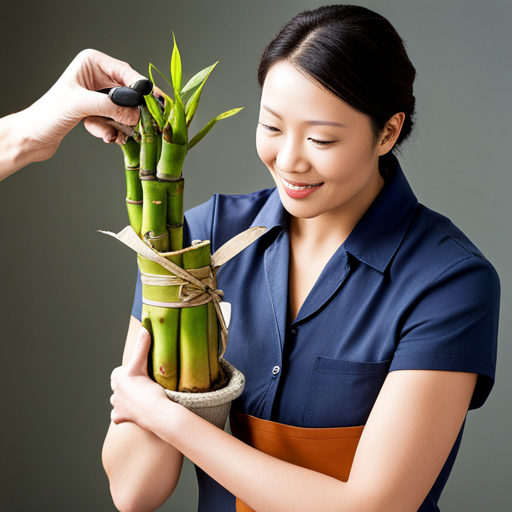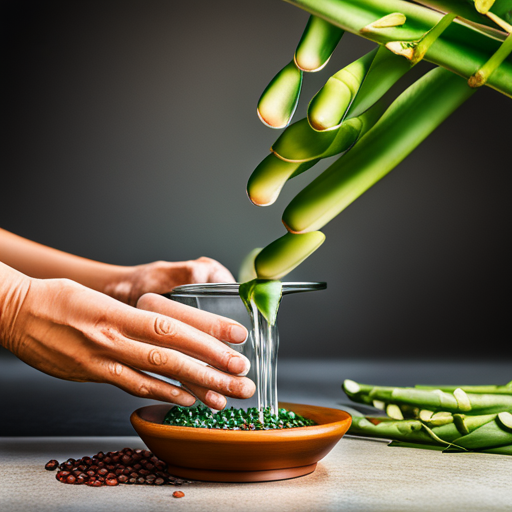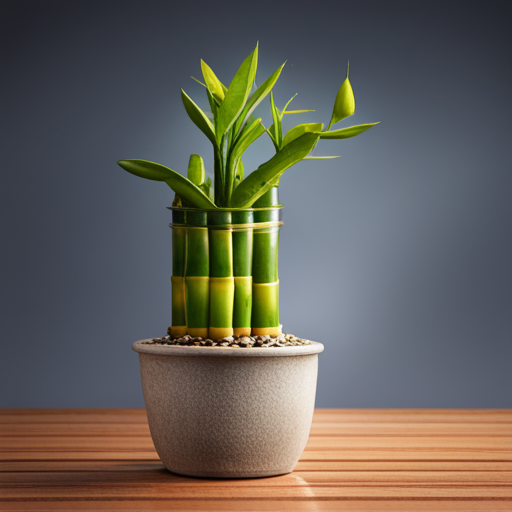It is essential to employ sharp and hygienic scissors to prevent bacterial contamination during the pruning process. Removal of yellow or dead leaves also stimulates the growth of fresh foliage and branches. By trimming the lower part of the plant and gradually progressing upwards, one can achieve the desired aesthetic.
Adequate watering, fertilization, and providing suitable lighting and temperature conditions contribute to the emergence of new shoots. Additionally, thin stalks can be revitalized by cutting them to the appropriate length and initiating new stalks. Proper care, including increasing humidity and employing lawn fertilizer for thicker stalks, is crucial for promoting vigorous growth.
This article will delve into effective pruning techniques, watering and fertilizing tips, and the factors necessary for optimal growth of Lucky Bamboo.
Contents
Our Highlighted Points
- Pruning the plant appropriately can stimulate the development of new branches and prevent excessive height.
- Removing yellow or dead leaves stimulates the growth of fresh foliage and branches.
- Adequate watering, fertilization, suitable lighting, and temperature conditions contribute to the emergence of new shoots.
Pruning Techniques

Pruning techniques play a crucial role in encouraging the growth of more branches in Lucky Bamboo plants. It helps maintain the plant’s height, stimulates the growth of new leaves and branches, and improves its overall appearance.
Lucky Bamboo plants have different branching patterns, and pruning can help shape the plant’s growth according to desired preferences. Pruning frequency should be determined based on the plant’s growth rate, and it is essential to prune the plant when it is not growing at a standard rate.
By removing yellow or dead leaves and cutting stalks at an ideal height, the plant can redirect its energy towards developing new shoots and branches. Patience, proper pruning tools, and techniques are necessary to ensure successful pruning, resulting in a healthier and more aesthetically pleasing Lucky Bamboo plant.
Watering and Fertilizing Tips

Watering and fertilizing the plant properly according to its specific needs is crucial for promoting healthy growth. Lucky Bamboo requires proper watering and a well-balanced fertilizing schedule to thrive. Here are some tips to ensure optimal growth:
- Watering: Lucky Bamboo should be watered with filtered or distilled water to avoid chlorine and other chemicals that can harm the plant. The soil should be kept consistently moist, but not overly saturated. It is important to avoid overwatering, as this can lead to root rot.
- Fertilizing: Lucky Bamboo benefits from a diluted, balanced liquid fertilizer. It is recommended to fertilize the plant every two to four weeks during the growing season (spring and summer) and reduce frequency during the dormant period (fall and winter). Over-fertilizing can cause the tips of the leaves to turn brown, so it is important to follow the instructions on the fertilizer package.
By following these watering and fertilizing tips, lucky bamboo can grow more branches and maintain its health and vitality.
Factors for Optimal Growth

Factors such as light intensity, temperature, and humidity levels are important considerations for promoting optimal growth in Lucky Bamboo plants. Maintaining the right balance of these factors can significantly influence the growth and overall health of the plant. Adequate light is essential for photosynthesis and should be provided without direct exposure to harsh sunlight. Lucky Bamboo thrives in temperatures ranging from 60-80°F (15-27°C), making it important to avoid extreme hot or cold conditions. Additionally, increasing humidity levels slightly can create a more favorable environment for growth. However, it is crucial to avoid excessive humidity as it can lead to fungal diseases. Another factor that can contribute to the growth of thicker stalks is the use of lawn fertilizer. Applying a diluted amount of lawn fertilizer once every two to three months can provide necessary nutrients for the plant’s growth. By carefully considering these factors, Lucky Bamboo can flourish and produce more branches.
| Factors | Optimal Range |
|---|---|
| Light intensity | Moderate to high |
| Temperature | 60-80°F (15-27°C) |
| Humidity levels | Slightly increased |
Can the Method of Growing Lucky Bamboo from Seeds Help in Growing More Branches?
Looking for a growing lucky bamboo seeds tutorial? While lucky bamboo is typically propagated from cuttings, some believe that growing lucky bamboo from seeds can result in a bushier plant with more branches. However, the success rate of growing lucky bamboo from seeds is relatively lower compared to propagation from cuttings.
Frequently Asked Questions
How long does it take for Lucky Bamboo to grow new shoots after pruning?
The time it takes for lucky bamboo to grow new shoots after pruning depends on various factors, including pruning techniques and optimal growing conditions. Under proper care, the plant can produce new shoots within a couple of weeks.
Can Lucky Bamboo be grown outdoors?
Lucky Bamboo is primarily an indoor plant and is not typically grown outdoors for optimal growth. However, for outdoor gardening, there are many other plants that are better suited for outdoor growing, depending on the climate and conditions.
How often should Lucky Bamboo be watered?
Lucky bamboo should be watered every 7-10 days, or when the top inch of soil feels dry. It thrives in well-draining soil and should not be overwatered, as it can lead to root rot.
Can Lucky Bamboo be propagated from cuttings?
Yes, lucky bamboo can be propagated from cuttings. To ensure successful propagation, it is important to select healthy stems with at least one node. Place the cuttings in water or a well-draining soil mix, keeping them in a warm and humid environment. Regularly misting the cuttings can also aid in their growth.
What are some common issues or pests that can affect the growth of Lucky Bamboo?
Common issues that can affect the growth of lucky bamboo include yellowing leaves, root rot, aphids, and spider mites. These problems can hinder the plant’s health and development, requiring proper care and attention to ensure its optimal growth.

